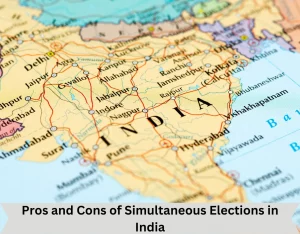ForumIAS announcing GS Foundation Program for UPSC CSE 2025-26 from 19 April. Click Here for more information.
ForumIAS Answer Writing Focus Group (AWFG) for Mains 2024 commencing from 24th June 2024. The Entrance Test for the program will be held on 28th April 2024 at 9 AM. To know more about the program visit: https://forumias.com/blog/awfg2024
Source: The post simultaneous elections in India has been created, based on the article “Pros and cons of simultaneous elections” published in “The Hindu” on 30th January 2024.
UPSC Syllabus Topic: GS Paper2- Indian Constitution- features, amendments, significant provisions and basic structure.
Pros and Cons of Simultaneous Elections in India, The article is about a proposal in India to hold simultaneous elections for the national parliament (Lok Sabha), state assemblies, and local bodies. It explores the benefits and challenges of this idea, focusing on aspects like cost, governance, and its impact on India’s democracy and federal system.
What is The Need for Simultaneous Elections in India?
To Reduce Election Costs: The cost of holding separate elections is high. With the Lok Sabha elections costing around ₹4,000 crore, adding state elections increases these costs. Simultaneous elections could drastically cut down these expenses.
To Avoid Constant Election Mode: Currently, political parties are in a continuous campaign mode due to frequent state elections. This distracts from governance and policy implementation. Simultaneous elections would enable a more focused approach to administration.
To Enhance Administrative Focus: Regular elections divert administrative resources and attention to election management. Simultaneous elections would free up these resources for more consistent governance throughout the year.
To Mitigate Social Polarization: The ongoing cycle of elections leads to polarizing campaigns, intensifying social divisions. Simultaneous elections would reduce the frequency of these campaigns, potentially easing social tensions.
What are The Challenges Involved in Holding Simultaneous Elections in India?
Overlapping of National and State Issues: Simultaneous elections could lead to national issues overshadowing regional ones, affecting the representation of state-specific concerns.
Reduced Feedback for Governments: Holding elections once every five years might limit the electorate’s ability to provide regular feedback, impacting policy responsiveness.
Need for Constitutional Amendments: Implementing simultaneous elections requires amending Articles 83, 85, 172, and 174 of the Constitution, which govern the duration and dissolution of the Lok Sabha and state assemblies. Additionally, amending Article 356, related to the President’s rule, is necessary.
Fixed Tenure Complications: Aligning the fixed tenure of both Lok Sabha and state assemblies is complex, especially when governments lose majority or seek early dissolution.
Want To Know More Topics-
Early nutrition impacts cognitive development
On Issues with Public Health in India – Populism do
What are The Various Recommendations Related to Simultaneous Elections in India?
Recommendations for Simultaneous Elections in India by Law Commission (1999, 2018) and Parliamentary Committees on Personnel, Public Grievances, Law and Justice (2015) are:
Staggered Election Cycles: Conduct Lok Sabha and half of the state assembly elections together, and the rest after two and a half years. This requires adjusting the tenures of current assemblies.
Linked ‘No-confidence’ and ‘Confidence’ Motions: Any ‘no-confidence motion’ should be accompanied by a ‘confidence motion’ for an alternative government. This discourages unnecessary dissolution of houses.
Shortened Tenure for Prematurely Dissolved Houses: If a house dissolves early, the new house should only serve the remainder of the original term. This aims to prevent frequent elections.
Annual By-Elections: Clubbing bye-elections caused by death, resignation, or disqualification, and conducting them once a year to streamline the process.
Way forward
Moving forward, apart from the measures already suggested, it’s essential to engage in a broad-based consensus among political parties, civil society, and constitutional experts. This collaborative approach can ensure that any shift towards simultaneous elections aligns with India’s democratic ethos and federal structure, while addressing practical challenges and respecting the constitutional mandate. This inclusive dialogue is key to successfully navigating the complexities of implementing simultaneous elections.
Question for practice:
Examine the key reasons for proposing simultaneous elections in India and the challenges associated with implementing this idea.





